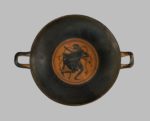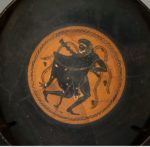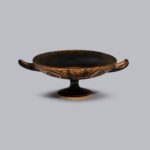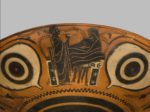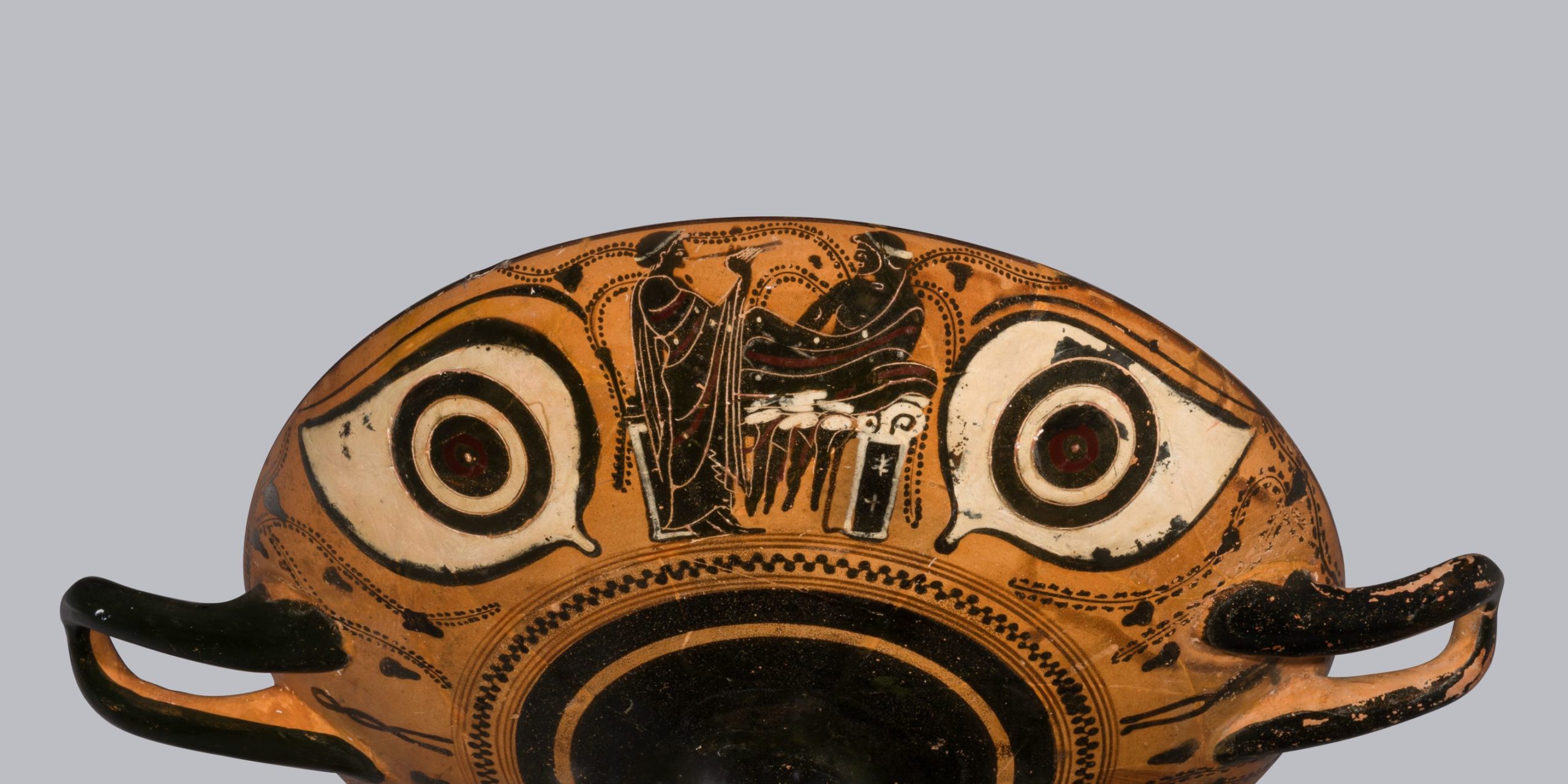
Eye Cup [Gr8]
Athenian Black-Figure, by the Theseus Painter, 520-510 BC
Painted terracotta (h. 12.5 cm, w. 36.2 cm), mended and restored
The interior painted black with a reserved line near the rim, tondo of Herakles wearing a lion skin and holding a club. On each side of the exterior a symposium scene, with a female musician standing behind a man reclining on a coach, framed by a large pair of eyes. The upper part of the scene on one side (without added white on the headdresses of the two figures) was originally missing and has been entirely restored and repainted.
The large eyes on the exterior of this cup are a distinctive feature of many black-figure kylikes (shallow drinking cups). Many different ideas have been put forward to explain their design: one possibility is that they were believed to ward off evil spirits. The eyes also made cups resemble the masks worn by actors in the theatre and by worshippers of Dionysus. When drunk from, these cups would have formed a mask of sorts of their own, the eyes covering those of the drinker.
In the interior of this cup is a figure of Herakles, nude except for a lion skin, and carrying a club. According to the myth, Herakles defeated the Nemean lion on the orders of King Eurystheus and gained its impervious pelt as a cloak. Heracles was the hero most frequently represented on black-figure vases, and references to the killing of the Nemean lion occur more frequently than any of his other twelve labours.
On the exterior of this cup are two figures at a symposium. This was a drinking party held by Athenian aristocratic (and later citizen) men where politics, myths, and philosophy were discussed with the aid of wine, music, dancing, and female hetairai (companions). Drinking vessels like this cup would have been used at a symposium, and were often decorated with scenes that refer to it. Here a man reclines on a coach, below which is a table with loaves of bread and strips of meat hanging from it. Behind him is a woman playing double pipes (diaulos).
The painter of this cup is known as the Theseus Painter, because several of his surviving vases show scenes from the legend of Theseus. At least 200 vases may be attributed to him, more than almost any other painter. Another cup decorated by him is in the Winchester Collection (Gr12). The Theseus Painter seems to have begun his career in the Krokotos workshop (see Gr7), with which his work has many stylistic similarities. He was active from about 520 to 480 BC, a period when the red-figure technique came to dominate Athenian vase painting. The Theseus Painter seems to have been the last really accomplished and inventive painter to work in black-figure. His vases have been found as far afield as Cyrene (in modern-day Libya), the west coast of Italy, Thasos and Rhodes.
Literature: O.E. Borgers, The Theseus Painter: Style, Shapes and Iconography (Amsterdam, 2007), no. 176 (p. 166), plate 40.f, pp. 56-58, p. 60 (n. 388), 117; J. Falconer and T. Mannack, Corpus Vasorum Antiquorum: Great Britain, Fascicule 19: Winchester College (Oxford, 2002), p. 3, plate 2.4-6; J. Dancy, Walter Oakeshott, a Diversity of Gifts (Norwich, 1995), p. 61; J.D. Beazley, Attic Black-Figure Vase-Painters (Oxford, 1956), p. 520.35; N. Oakeshott, ‘Three Black-figured Vases in the Winchester College Museum’, Journal of Hellenic Studies 59 (1939), pp. 284-6, fig. 1; C. Haspels, Attic Black-figured Lekythoi (Paris, 1936), pp. 146, 252, no. 76.
Provenance: Discovered in fragments in a packing case in the art-room (above Chantry) in 1935, wrapped in newspaper dated 1904 (with Gr66)
Location: Treasury, Gallery 3

